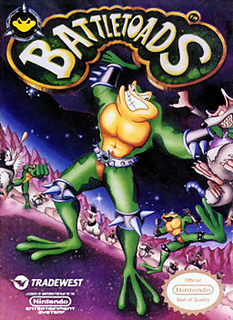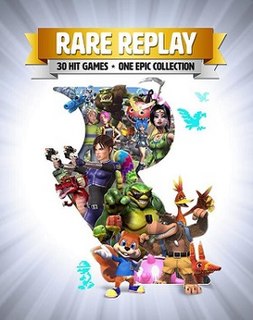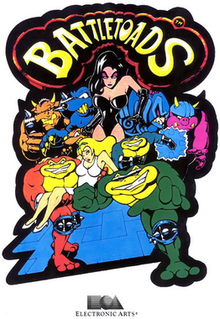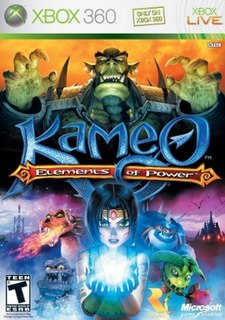
Donkey Kong Country is a 1994 platform game developed by Rare and published by Nintendo for the Super Nintendo Entertainment System (SNES). It is a reboot of Nintendo's Donkey Kong franchise and follows the gorilla Donkey Kong and his nephew Diddy Kong as they set out to recover their stolen banana hoard from the crocodile King K. Rool and his army, the Kremlings. The single-player traverses 40 side-scrolling levels as they jump between platforms and avoid obstacles. They collect items, ride minecarts and animals, defeat enemies and bosses, and find secret bonus stages. In multiplayer modes, two players work cooperatively or race each other.

Donkey Kong Country 3: Dixie Kong's Double Trouble! is a 1996 platform video game developed by Rare and published by Nintendo for the Super Nintendo Entertainment System (SNES). It was released on 18 November 1996 in North America, on 23 November 1996 in Japan, and on 13 December 1996 in Europe and Australia. It is the third installment of the Donkey Kong Country series and serves as a direct sequel to Donkey Kong Country 2: Diddy's Kong Quest. It was also re-released for the Game Boy Advance (GBA) in 2005. The game was made available to download on the Wii's Virtual Console service in 2007, as well as for the Wii U's Virtual Console in 2014.

Rare Limited is a British video game developer and a studio of Xbox Game Studios based in Twycross, Leicestershire. Rare's games span the platform, first-person shooter, action-adventure, fighting, and racing genres. Its most popular games include the Battletoads, Donkey Kong, and Banjo-Kazooie series, as well as games like GoldenEye 007 (1997), Perfect Dark (2000), Viva Piñata (2006), and Sea of Thieves (2018).

Blast Corps is an action game developed by Rare and published by Nintendo for the Nintendo 64. In the game, the player uses vehicles to destroy buildings in the path of a runaway nuclear missile carrier. In the game's 57 levels, the player solves puzzles by transferring between vehicles to move objects and bridge gaps. It was released in March 1997 in Japan and North America. A wider release followed at the end of that year.

Battletoads is a beat 'em up/platform video game developed by Rare and published by Tradewest. It is the first installment of the Battletoads series and was originally released on 1 June 1991 for the Nintendo Entertainment System. It was subsequently ported to the Mega Drive and Game Gear in 1993, to the Amiga and Amiga CD32 in 1994, and released with some changes for the Game Boy in 1993 in the form of Battletoads in Ragnarok's World. In the game, three space humanoid toad warriors form a group known as the Battletoads. Two of the Battletoads, Rash and Zitz, embark on a mission to defeat the evil Dark Queen on her planet and rescue their kidnapped friends: Pimple, the third member of the Battletoads, and Princess Angelica.

Knight Lore is a 1984 action-adventure game developed and published by Ultimate Play the Game, and written by company founders Chris and Tim Stamper. The game is known for its use of isometric graphics, which it further popularized in video games. In Knight Lore, the player character Sabreman has forty days to collect objects throughout a castle and brew a cure to his werewolf curse. Each castle room is depicted in monochrome on its own screen and consists of blocks to climb, obstacles to avoid, and puzzles to solve.

Solar Jetman: Hunt for the Golden Warpship is a multi-directional shooter video game developed by Zippo Games and Rare and published by Tradewest in North America and by Nintendo in Europe. It was released in North America on 14 October 1990 and in Europe on 26 September 1991 for the Nintendo Entertainment System. The game is the third installment of the Jetman series and was later re-released by Nintendo for their NES-based PlayChoice-10 arcade system in the United States in 1990.

R.C. Pro-Am is a racing video game developed by Rare and published by Nintendo in North America in February 1988, and then in Europe on April 15. Presented in an overhead isometric perspective, a single player races a radio-controlled car around a series of tracks in vehicular combat. Each track qualifies its top three racers for the next track. Collectible power-up items improve performance, hazards include rain puddles and oil slicks, and missiles and bombs can temporarily disable opponents. Originally titled Pro Am Racing, it was ported to the Sega Genesis in 1992 as Championship Pro-Am, an enhanced remake with enhanced graphics and additional features. R.C. Pro-Am spawned two sequels: Super R.C. Pro-Am in 1991, and R.C. Pro-Am II in 1992.

Snake Rattle 'n' Roll is a platform video game developed by Rare. It was published by Nintendo and released for the Nintendo Entertainment System in North America in July 1990 and in Europe on March 27, 1991. The game features two snakes, Rattle and Roll, as they make their way through eleven 3D isometric levels. A Mega Drive version was released by Sega in June 1993 with an extra level. Snake Rattle 'n' Roll was developed by Rare members Tim Stamper and Mark Betteridge. The music was composed by David Wise and was inspired by "Shake, Rattle and Roll" and other 1950s-era songs.

R.C. Pro-Am II is a racing video game developed by Rare and released by Tradewest for the Nintendo Entertainment System on December 11, 1992. The game is the sequel to the 1988 R.C. Pro-Am and features similar gameplay with a wider variety of tracks, currency-based vehicle and weapon upgrades, and bonus stages. In R.C. Pro-Am II, four players, either human or artificial intelligence, race on a series of tracks to finish first while avoiding obstacles and hazards. The winner receives race points and money. The game features a multiplayer mode in which up to four human players can compete against each other simultaneously.

Gunfright is an action-adventure game developed by Ultimate Play the Game and published by U.S. Gold. It was first released for the ZX Spectrum in December 1985, then released for Amstrad CPC and the MSX the following year. The player takes the role of a sheriff in the town of Black Rock and is tasked with eliminating outlaws who are scattered throughout the settlement.

Slalom, originally released as VS. Slalom, is a skiing sports video game developed by Rare and published by Nintendo in 1986 for the Nintendo VS. System in arcades. It was then released for the Nintendo Entertainment System in North America in March 1987 and in Europe later that year. The player races in a series of downhill slalom skiing runs while navigating past flags and obstacles before time expires. It was developed by Tim and Chris Stamper and its music was composed by David Wise.

Digger T. Rock: Legend of the Lost City is a platform video game developed by Rare and published by the Milton Bradley Company for the Nintendo Entertainment System. It was first released in North America in December 1990 and in Europe in 1991. The game centres around the miner Digger T. Rock, as he spelunks various caves and catacombs whilst searching for the mythical Lost City.

Isolated Warrior is a 1991 video game developed by KID and published in Japan by Vap, in North America by NTVIC, and Europe by Nintendo. It falls in the shooter genre, although its gameplay also includes elements reminiscent of platforming, while it features isometric projection, similar to Sega's Zaxxon.

Project Dream was the codename of a role-playing video game (RPG) that served as the basis for the 1998 game Banjo-Kazooie. Developed by Rare, it was aimed for release on the Super Nintendo Entertainment System (SNES), and later the Nintendo 64 (N64). The plot followed a young boy, Edson, who caused trouble with pirates. The SNES version of Dream used an isometric perspective and had a fairy tale theme. After transitioning to the N64, the project became a more complex 3D RPG that had a greater emphasis on the pirate theme. Eventually, Dream was scaled back to a linear platform game in the vein of Donkey Kong Country (1994) that starred Banjo the bear, who became the protagonist of Banjo-Kazooie.

Rare Replay is a 2015 compilation of 30 video games from the 30-year history of developers Rare and its predecessor, Ultimate Play the Game. The emulated games span multiple genres and consoles—from the ZX Spectrum to the Xbox 360—and retain the features and errors of their original releases with minimal edits. The compilation adds cheats to make the older games easier and a Snapshots mode of specific challenges culled from parts of the games. Player progress is rewarded with behind-the-scenes footage and interviews about Rare's major and unreleased games.

Killer Instinct Gold is a 1996 fighting video game based on the arcade game Killer Instinct 2. The game was developed by Rare and released by Nintendo for the Nintendo 64 video game console. As in other series entries, players control characters who fight on a 2D plane set against a 3D background. Players press buttons to punch and kick their opponent in chains of successive hits, known as combos. Large combo successions lead to stronger attacks and brutal, stylistic finisher moves underscored by an announcer. Characters—including a gargoyle, a ninja, and a femme fatale—fight in settings such as a jungle and a spaceship. Killer Instinct Gold includes the arcade release's characters, combos, and 3D, pre-rendered environments, but excludes its full-motion video sequences and some voiceovers due to restrictions of the cartridge media format. The Gold release adds a training mode, new camera views, and improved audiovisuals.

Battletoads Arcade, also known as Super Battletoads or just Battletoads, is a 1994 scrolling beat 'em up arcade game in the Battletoads series developed by Rare and published by Electronic Arts. Up to three players, as the Battletoads, brawl aliens and mutant rodents through six levels to save the universe from the Dark Queen. The game also includes vertical and bonus levels. Each Toad has its own signature attack, and as customary for the series, players can knock enemies towards the screen, breaking the fourth wall.

Kameo: Elements of Power is a 2005 action-adventure video game developed by Rare and published by Microsoft Game Studios. The player controls Kameo, a 16-year-old elf, who must travel across the land, rescuing her family while collecting Elemental Sprites and Warriors in a Beat 'Em Up style combat against the trolls that stand in her way. Kameo's ten elemental powers let her transform into creatures and use their varied abilities to solve combat-oriented puzzles and progress through the game's levels.

Brothers Tim and Chris Stamper are British entrepreneurs who founded the video game companies Ultimate Play the Game and Rare. They first worked together on arcade conversion kits, which were licensed to companies, but later became developers for the ZX Spectrum home computer in the early 1980s. Chris programmed the games, while Tim designed the graphics. They found success as Ultimate with games including Jetpac and Knight Lore. After reverse engineering the Nintendo Entertainment System and deciding to shift their focus to console development, the brothers founded Rare in the mid-1980s. They became Nintendo's first major Western developer, for whom they developed licensed games and ports. Over the next two decades, Rare enjoyed a close relationship with Nintendo and developed multiple major titles for the company, including Donkey Kong Country and GoldenEye 007. Microsoft acquired Rare in 2002, and the brothers left the company in 2007. After spending several years out of the public eye, the brothers are currently planning new ventures.





















